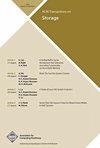日志结构合并键值库中强确定性契约的实现
IF 2.6
3区 计算机科学
Q3 COMPUTER SCIENCE, HARDWARE & ARCHITECTURE
引用次数: 0
摘要
我们提出了Vigil KV,这是一个硬件和软件共同设计的框架,通过引入强延迟确定性,几乎完美地消除了长尾延迟。为了使Get latency具有确定性,Vigil KV首先在真正的数据中心规模的NVMe SSD上启用了可预测延迟模式(PLM)接口,了解底层闪存技术的性质。然后,系统级的Vigil KV通过在多个物理功能上对PLM的不同设备状态进行内部调度来隐藏不确定的时间窗口(与SSD的内部任务和/或写入服务相关)。Vigil KV在意识到PLM限制的情况下,进一步安排压缩/刷新操作和客户端请求,从而将强大的延迟确定性集成到LSM KV中。我们在1.92TB NVMe SSD原型和Linux 4.19.91上实现了Vigil KV,但其他LSM KV可以采用它的概念。我们用Vigil KV评估了不同的Facebook和Yahoo场景,结果表明,Vigil KV可以将基线KV系统的尾部延迟减少3.19倍,同时平均将平均延迟减少34%。本文章由计算机程序翻译,如有差异,请以英文原文为准。
Realizing Strong Determinism Contract on Log-Structured Merge Key-Value Stores
We propose Vigil-KV, a hardware and software co-designed framework that eliminates long-tail latency almost perfectly by introducing strong latency determinism. To make Get latency deterministic, Vigil-KV first enables a predictable latency mode (PLM) interface on a real datacenter-scale NVMe SSD, having knowledge about the nature of the underlying flash technologies. Vigil-KV at the system-level then hides the non-deterministic time window (associated with SSD’s internal tasks and/or write services) by internally scheduling the different device states of PLM across multiple physical functions. Vigil-KV further schedules compaction/flush operations and client requests being aware of PLM’s restrictions thereby integrating strong latency determinism into LSM KVs. We implement Vigil-KV upon a 1.92TB NVMe SSD prototype and Linux 4.19.91, but other LSM KVs can adopt its concept. We evaluate diverse Facebook and Yahoo scenarios with Vigil-KV, and the results show that Vigil-KV can reducethe tail latency of a baseline KV system by 3.19× while reducing the average latency by 34%, on average.
求助全文
通过发布文献求助,成功后即可免费获取论文全文。
去求助
来源期刊

ACM Transactions on Storage
COMPUTER SCIENCE, HARDWARE & ARCHITECTURE-COMPUTER SCIENCE, SOFTWARE ENGINEERING
CiteScore
4.20
自引率
5.90%
发文量
33
审稿时长
>12 weeks
期刊介绍:
The ACM Transactions on Storage (TOS) is a new journal with an intent to publish original archival papers in the area of storage and closely related disciplines. Articles that appear in TOS will tend either to present new techniques and concepts or to report novel experiences and experiments with practical systems. Storage is a broad and multidisciplinary area that comprises of network protocols, resource management, data backup, replication, recovery, devices, security, and theory of data coding, densities, and low-power. Potential synergies among these fields are expected to open up new research directions.
 求助内容:
求助内容: 应助结果提醒方式:
应助结果提醒方式:


